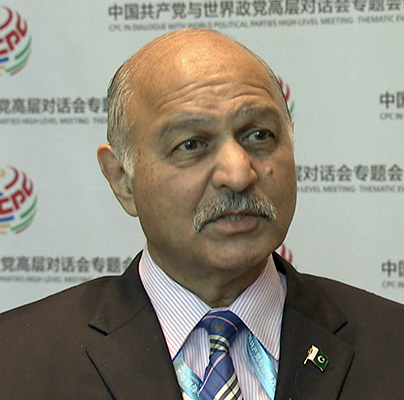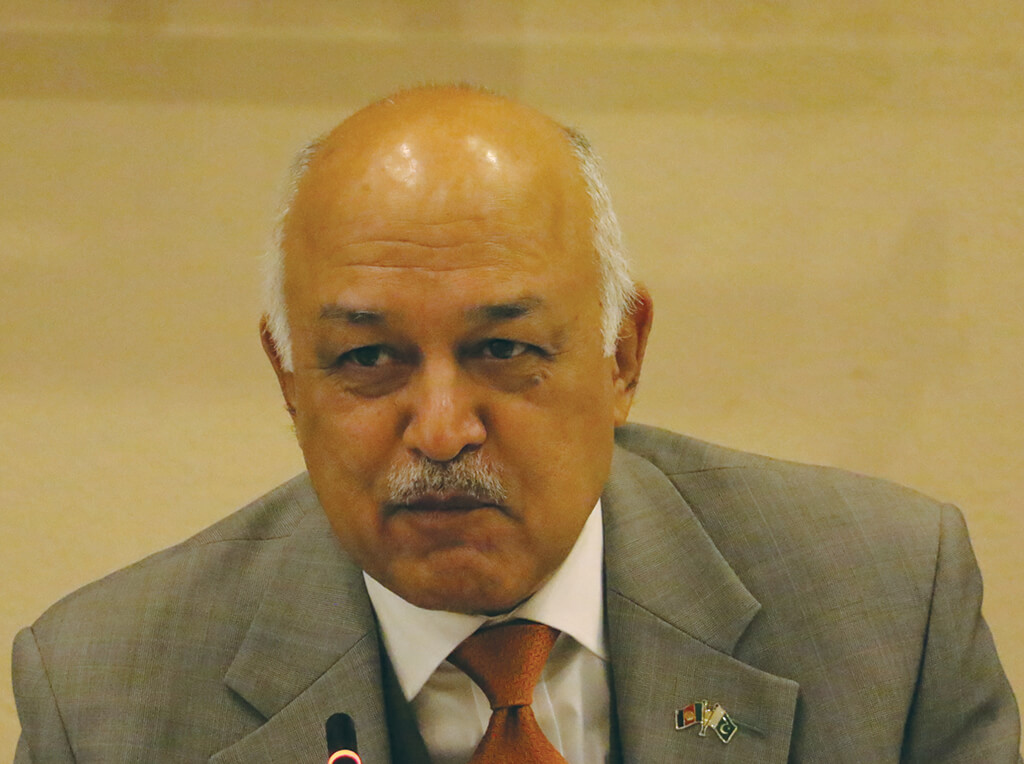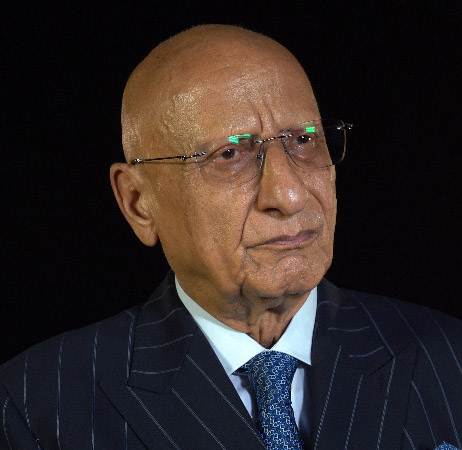There has been no change in the ground situation in occupied-Kashmir, which was illegally merged into the Indian union territory by the hardline Hindu nationalist government of Prime Minister Modi. Yet, Pakistan’s top civil and military leaders are willing to engage with India in a bid to give peace a chance. But are their expectations of striking a deal with India realistic? This month’s ‘Big Question’ is…
Narratives’ asked Senator Mushahid Hussain Syed, a senior Pakistan Muslim League-Nawaz leader and foreign relations expert, Lt. Gen. (Retired) Asif Yasin Malik, a former defence secretary, and Zafar Hilaly, a prominent political analyst and former diplomat, to give their views on the subject.
A Circumstantial Peace?

Senior Leader, Pakistan Muslim League
There have been a number of important developments in the region where Pakistan and India are located. These developments have had two key consequences. Firstly, they have yielded strategic space for Pakistan —a geo-political breather of sorts — for a number of reasons. These include the CPEC entering the second phase, and the country’s rock-solid relations with China, with the result that now Pakistan is emerging as the hub of regional connectivity. This is probably for the first time in our foreign policy history that China, the United States and Russia are simultaneously wooing Pakistan as they all need it in the regional context. The United States is dependent on Pakistan to provide what it calls an honourable-exit from Afghanistan. Washington now feels that the road to peace to Kabul lies through Islamabad, or more appropriately through Rawalpindi. With the Russia-China alliance cemented, and Moscow disillusioned with India’s cosiness with the United States, it is also reaching out to Pakistan. The Iran-China strategic partnership is a plus for Pakistan because China has displaced India on its Western flank, which will hopefully stabilise Balochistan, and strengthen the CPEC, specially the Gwadar Port.
India has always seen Pakistan through a zero-sum game mindset in which Pakistan’s benefit is India’s loss and vice-versa. The reasons for India’s U-turn towards Pakistan can best be understood in this context. There is an Indian fear of a two-front situation developing following the thrashing it received from China in May 2020 and January 2021. So, we should credit China for India’s U-turn and opening up towards Pakistan. Then there is the American factor. The Americans are relying on Pakistan for the fulfilment of their Afghanistan strategy, and as expected by Pakistani policy-makers for a long time, the United States after losing yet another land war in Asia, has decided to “cut and run.”
Finally, another reason for Modi’s U-turn is the domestic situation; with a divided and demoralised India after the beating from China, the Modi regime is facing its worst domestic crisis in the form of the coronavirus pandemic and faltering economy.
But let’s be clear about the fact that this is all to defuse tension and to attain at least a degree of normalisation of relations, but without any peace process, or resolution of festering conflicts like Kashmir or Siachen. Instead of talking at each other, Pakistan and India are now talking to each other, with some prodding from mutual friends. But the ball is in the Indian court, whether it is ready to change its hostile attitude and animosity towards Pakistan, or whether they are just buying time as they did 50 years ago in 1963 when they agreed to talk about Kashmir through the Bhutto-Swaran Singh talks after the Indian humiliation at the hands of China in the 1962 conflict. So for Pakistan the litmus test is whether India will move forward for normalisation by withdrawing its veto on the SAARC summit or stopping efforts to destabilise Pakistan via cross-border terrorism, which according to the foreign office dossier on Indian state-terrorism issued in November 2020 stated that there are 87 terrorist-training RAW camps operating against Pakistan — 66 in Afghanistan and 21 in India.
Actions speak louder than words. So far, India has not even said a simple thank you to Pakistan’s offer for support in the pandemic. In order to spite Pakistan, India was even willing to lose a match in the cricket World Cup so that Pakistan could not benefit from their victory. So, the main problem is the mindset of the Indian establishment and unfortunately it has been reinforced, and worsened with the Hindutva-driven foreign policy.
Peace with India is certainly possible provided there is a sea-change in the Indian establishment’s mindset towards Pakistan. India is a big country with a small heart, which borders on pettiness towards Pakistan. A change in the status-quo in Kashmir has to be the key ingredient of any peace process, while the Indian attitude of demonising and destabilising Pakistan has to change. If this were to happen, the sky is the limit for the Pakistan-India relationship. They can be partners not just in peace, but regional connectivity and a better tomorrow can certainly dawn for the one-fifth of humanity, which lives in South Asia. For that, a Nixonian vision is needed from India. Its size should match this vision. Atal Bihari Vajpayee — the late predecessor of Narendra Modi — was perhaps one of the greatest statesmen of South Asia. He had real vision. If Modi were to follow in Vajpayee’s footsteps, he will help change the destination of not only his own people, but that of Asia.
Perma Frost

Former Defence Secretary
In recent days and weeks most analysts and commentators appear to be excited about the glimmer of prospects of peace on the Indo-Pakistan front. Every related or unrelated happening and activity is somehow being tagged as a step towards the sweetening of Indo-Pak relations. For example, just the communication between the DGMOs on the two sides was being termed as a turning point. No one, it seems, remembers that the present ceasefire is the consequence of a unilateral ceasefire declared by Pakistan during the Musharraf government. Also, that Pakistan offered India a formal agreement to sign, but it has not done so to date. So, thus far at least, this remains merely a convenience measure for India.
Peace has different connotations for Pakistan and India. For Pakistan it embodies an honourable existence with an independent policy, pursuance space and rights. It means freedom without limits, restrictions or strings and equal rights on the regional and global mosaic. For India, peace means a regional hegemonic posture with the right to bully smaller countries and overrule norms and conventions.
These two postures are divergent, particularly in the backdrop of repeated declarations by numerous Indian leaders that the concept of Mahabharat has to be reverted to, and all territories separated in 1947 have to be annexed to fall into Akhand Bharat. Such peace could thus cost Pakistan its very existence.
Coming to the present environment, where a lot of external pull and push is being exerted on Pakistan to accept an unconditional peace with India, particularly in the context of its stance on Kashmir, especially with reference to the present Holocaust-like situation after August 5, 2019. These pressures are almost all aimed at compelling Pakistan to accept the so-called peace at all costs. Basically, the whole western world is looking at the 1.36 billion people market which is fast slipping into the Chinese sphere. To counter this, Washington is interested in propping up India, bolstering its position as a regional bully, as a proxy for its own policies in the region. And under this garb India is being armed to the teeth.
Peace with India is being projected in Pakistan as a contributor to the economic well-being of the Pakistani public. Actually, the Indians will flood the Pakistani market with substandard, cheap Indian products, thereby undermining our own industry. Even in the agricultural sector, we had witnessed serious setbacks for Pakistani farmers when we were importing agricultural products from India.
Sino-Indian skirmishes in the last two years are also a factor in India’s efforts to ask all its friends to leverage Pakistan to cool down the western front, thus allowing India to tackle the perceived Chinese threat. In this context, the Indians are mistaken that Pakistan is a factor in their military equation with the Chinese. India will never be able to meet the ever-growing Chinese politico-military influence.
The final factor remains the Pakistani response to Indian ceasefire violations, among them those against the civilian population of Azad Kashmir. The Pakistani military has inflicted serious damage on the Indian military, including the shooting down of two fighter aircraft last year. These responses have yielded serious morale issues, in addition to combat fatigue on the Indian forces deployed in Occupied Kashmir.
On the global front, the Gulf States are contributing to western designs to prop up India as a counter to increasing Chinese influence in the region. Coercing Pakistan to bow to Indian conditionalities will be a major achievement, for which the Arabs expect to earn the goodwill of the US.
Therefore, Pakistan needs to consider a few strategies: (a) Pakistan should remain steadfast in its stance on Kashmir. This is not the price for peace. (b) All hindrances to the execution of CPEC projects must be removed and such works completed as soon as possible. (c) A mass media campaign has to be launched to educate the public against the propaganda favouring peace with India. (d) We have to create favourable conditions for allowing our industries to export their goods. (e) And finally, serious efforts must be made in the domain of foreign policy to not only address the aforementioned problems vis-a-vis the pressure on Pakistan from various global and regional players, but also to launch an effective campaign to make the world understand our perspective on various issues, foremost among these: our relations with India.
Sleeping with the Enemy

Political analyst & former diplomat
Talking to India without New Delhi first retracting its August 5, 2019 illegal steps in Occupied Kashmir is akin to legitimising them. It will send a wrong message to the World, particularly to Kashmiris, that even Pakistan has backtracked on the UN resolutions and accepted the new position which India has forced onto them. Therefore, people are right in asking what we are talking about. But more important than that, they are rightly asking whom are we talking to. The man who says that the proudest moment of his life was when he worked for the creation of Bangladesh? The man who openly boasts that thousands of RSS thugs infiltrated into the former East Pakistan in the guise of ‘Mukti Bahini,’ and who wants the disintegration of the remaining part of Pakistan? What can we secure from this man that could be acceptable to our people?
The testimony given to the Commission to investigate the Gujrat riots of 2002 reveals the instructions given to the police by Narendra Modi — who was chief minister at that time — to not interfere with, or prevent the massacre of Muslims. Muslim MP from Gujrat, Ehsan Jafri, was hacked to death limb by limb in the presence of the police. When Modi became Prime Minister of India in 2014, savagery against Muslims increased as never witnessed before in India. The whole world acknowledges this fact. We can expect nothing from such a man in terms of peace and reconciliation.
If Pakistan talks to India now without setting any conditions, it would simply mean that we have accepted the status quo in Kashmir. If we hold talks with India when it has scrapped Article 370 and 35A, which gave nominal rights to Kashmiris, it means that Pakistan has accepted the annexation and absorption of Kashmir into the Indian union territory, and in this manner ended the Kashmir dispute by handing it over to India. Then all that would exist is the Indian claim on Azad Kashmir and Gilgit-Baltistan.
What is the pressure on us to talk to India? We are told it is the poor and deplorable state of our economy, but I say it is the poor leadership, the current hybrid system, and the constitution, which is ill-suited to the country’s requirements. It is not just festering revolts and corruption, but also the defeatist mindset which is evident in the way this leadership is willing to oblige India.
Initially, it was understandable that the two armies were talking to restore a measure of calm at the Line of Control (LoC) and end active hostilities. But beyond that there is no sense in talking to India as it has refused to retract its August 5, 2019 measures. What else is there to talk to India about apart from Kashmir? Should we just be content to discuss trade and other minor problems with them?
Peace between Pakistan and India is not possible until New Delhi at least goes back to the prior August 5, 2019 position. This should be followed by the mutual reduction of forces and removal of heavy military equipment within at least 50 miles of the border. Will India be ready to do this?
The current back channel parleys will lead to nothing. There can be no agreement until the Kashmir issue is resolved. If the Kashmir dispute is solved, everything else will automatically be solved. If India want access to trade routes to Afghanistan and Iran — the goodies we can offer — then the question is what India will give us in return? Just opening trade between the two countries will only benefit India — as evidenced by experience.
Bilateralism between Pakistan and India led to nothing in the past. India is trying to stop our water, it has violated all the agreements and seized what it could — including the Siachen Glacier.
Musharraf’s idea of a soft border in the divided region of Kashmir, people crossing over back and forth, coming and going, was practical, but Modi has scrapped all the chances of even such an agreement. Why does Modi need to annex Kashmir? To assimilate it into Indian territory, because of his Hindutva agenda, the RSS creed. A dissection of Bharatmata remains unacceptable to him and all Hindu fanatics. An uneducated man like Modi, we must remember, cannot act like Manmohan Singh or Atal Bihari Vajpayee.



